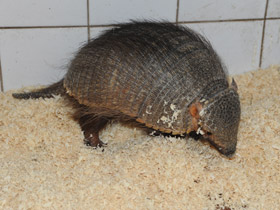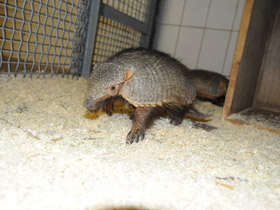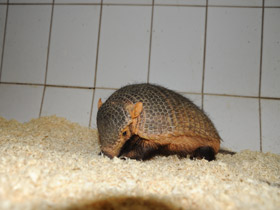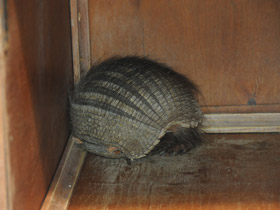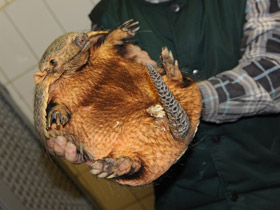Order Armadillos Cingulata
Armadillo means "little armoured one" in Spanish. The armadillos are now classified in separate order (previously they were grouped together under order Xenarthra). Armadillos are amazing: they are the only living mammals that have bony plates on their back, head, legs, and tail; these plates form a number of bands on the body of the armadillo. The armour serves as a perfect protection against enemies but it does not seem to significantly restrict armadillos’ mobility.
In contrast with representatives of the order Xenarthra, the armadillos have numerous peg-like cheek teeth but their teeth are primitive: they lack enamel and have open roots that allow for continuous growth of the teeth. All 20 extant species of the armadillo are found in South and Central America (only the nine-banded armadillo occurs in the south of North America; this armadillo is presented on the photos here). These odd creatures appear to be a conglomeration of other animal parts: the long tongue of an anteater, the bony shell of a turtle, the face of a pig, and the ability to curl into a ball, like a hedgehog (though there are only two species of the armadillo that are capable of curling into a ball – see photo 8). Armadillos live in open habitats; they are terrestrial animals adapted to digging. When threatened, armadillos can in a few minutes dig a hole in the ground and hide. When digging a burrow, the armadillo has a unique ability to hold its breath for up to six minutes. This ability also allows the armadillos to hide from their enemies underwater. The armadillo can run fast when in danger and it is also able to stand up on its hind legs (Photos 6 and 7). Armadillo diet includes a wide variety of foods such as insects, mollusks, worms, and other invertebrates, as well as small vertebrates, carrion, and plants. The armadillos generally feed at night.
Pregnancy in armadillos is very long due to the female’s ability to delay implantation of the fertilized egg during times of stress (it is called latent period). Typical litter sizes range from one to eight, with all the embryos being of the same sex since they develop from the same egg. The female gives birth to her young in a den which she builds in her burrow. The young are born with soft leathery skin which hardens within a few weeks. They grow fast and start eating “adult” food quite soon.
Armadillos play an important role in Indian folklore and mythology. Unfortunately, these animals are persecuted for their disruptive burrowing on agricultural land. Armadillos’ rooting also destroys crops and gardens; besides, armadillos dig holes in the pastures and the horses and cows often step in these holes and break their legs. Armadillos are extensively hunted and traded by local people, both for their meat and for their shell, which is used to make decorative boxes, musical instruments, and souvenirs. All these factors have led to the decline of the populations of many armadillo species. However, the armadillos as a group are not considered to be under the treat of extinction; they rather thrive because they are omnivorous animals, well protected from their enemies.
The large hairy armadillo Chaetophractus villosus
The carapace (armour) of the large hairy armadillo consists of approximately 18 bands, 7 to 8 of which are movable. The undersides of the large hairy armadillo are densely covered with whitish or light brown hairs, while long, coarse hairs project from the body armour plates. In Argentina, this armadillo is called “peludo” which means “hairy”. The large hairy armadillo, as the name suggests, has more hair than other armadillos. Powerful claws on the forefeet of the large hairy armadillo’s feet make this animal the best burrower among all armadillos.
The large hairy armadillo is found in South America, from northern Paraguay, to the Gran Chaco of Bolivia to central Argentina. Large hairy armadillos occur in a wide variety of habitats such as grasslands (including pampas and Chaco), savannahs, and forests. They also live in the mountains at elevations of up to 3000 meters. The large hairy armadillo shelters in numerous burrows which it digs in the ground; the length of the burrows usually does not exceed two meters. In summer, large hairy armadillos are mainly nocturnal, while in winter, they are mainly active in the daytime. This armadillo feeds on various insects, mollusks, worms, mushrooms, fruit and seeds of plants, and carrion; sometimes they hunt small frogs and lizards.
The large hairy armadillo female generally produces two litters annually. Gestation lasts 60 days, after which the female usually gives birth to two young. When the pups are born, their shell is soft and grey and feels like leather. They stay in the den for about one month; they are weaned when they are 50-60 days old. The young reach sexual maturity at 9 months of age.









